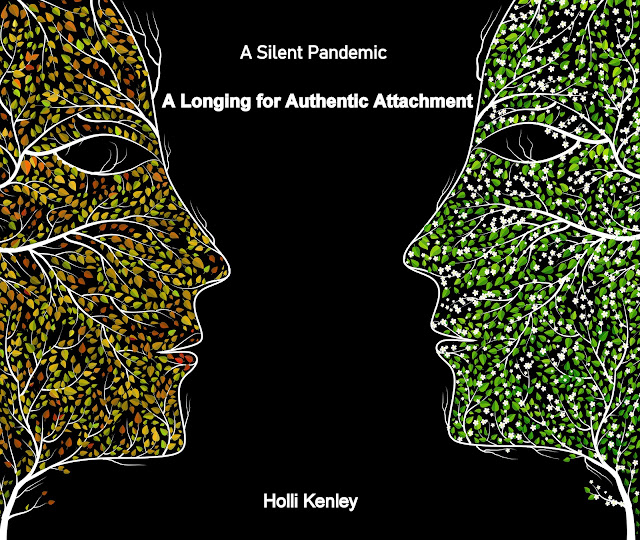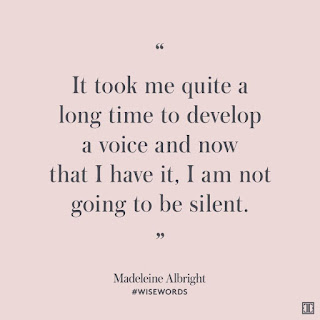A Silent Pandemic: A Longing for Authentic Attachment
"Something was missing. I felt off."
A few months ago, I had the opportunity to present a virtual parenting class in the state of Michigan. Nothing really new to me. Except this time, I was excited to reach a broader audience -- nineteen library communities would be connecting through one centralized district office.
At 2:00 pm Pacific
Standard Time, I closed my blinds in my bright office and carefully arranged my
desk, white light, microphone, camera, materials, and double-checked my power-point
slides. Yep. Everything was ready.
At 2:40 pm, tech guru Phillip welcomed me into StreamYard,
the platform we would be utilizing. We chatted for a few minutes. Then, as
instructed, I uploaded my power-point. I struggled for moment as this format
was new to me. With Phillip’s help, we got everything working.
We began promptly at 3:00 pm. For the next 90 minutes, I
stared at my screen delivering the workshop.
I could not see any participants, I could not see Phillip, and I could
not see myself. I could not see the chat, although Phillip monitored it
beautifully.
After the workshop, I sat alone in my office. Although the workshop went well, I felt off.
That evening I told my husband that something was missing. The next day, I still felt unsettled.
In my quiet time of reflection, I realized what was
off. I knew what I was missing – my need
for attachment to my audience. I needed to see them. I needed them to know they were seen by me. I
needed to experience human connection and its essential requirement for learning.
I wondered if parents needed it too?
Have you ever felt that way? Have you ever felt that with
all the wonders of technology that you are missing something? Is there a longing
inside of you for authentic attachment?
Let’s pause for a moment and RETHINK our relationship with our electronic devices.
"We have an attachment to our devices."
Yes, these devices can make our lives easier. No question. We
depend on them for almost everything. We have them with us and on us. It isn’t
uncommon to spend hours each day holding them in our hands. Sometimes, we get
nervous when we can’t find our phones or we might feel anxious when we’re not
checking our messages, texts, etc.
This is normal. We
have an attachment to our devices. In
the 1950’s, Founder of Attachment Theory, Dr. John Bowlby (1969), identified
that “Prior to birth and from birth forward,” that a process of attachment –
where there is a presence of “lasting psychological connectedness between human
beings”— is necessary for healthy development.
Let’s take a closer look at what attachment is and how it
meets our needs.
According to Dr. Saul McLeod, “Attachment can be defined as
a deep and enduring emotional bond between two people in which each seeks
closeness and feels more secure when in the presence of the attachment figure” (“Attachment
Theory.” Simple Psychology, 7 Feb. 2017).
The key words in this definition are “deep and enduring
emotional bond” and “each seeks closeness and feels more secure.”
As we think about those words, we are left wondering if our
devices are meeting our need for a “deep and emotional bond” or for “closeness”
and feeling “more secure.”
"It feels really good to be seen."
For the past several weeks, I have been working with a
couple who is struggling on many levels, especially around their communication.
The female partner gets frustrated when her expectations of her spouse are not
met and she becomes quite angry. The male partner detests conflict and quickly
shuts down when he is met with anger. He typically escapes into his phone or
video games.
Two weeks ago in session, I guided them through a three-part
exercise. Each partner took a turn expressing their feelings, the reasons
behind their feelings, and what each needed. They faced each other. The looked into each other’s eyes. They held one another’s hands. They did not interrupt each other. Each
listened intently and when it was time, each reflected back what was said.
Watching the couple, I could feel their authentic attachment
taking hold. They could too. Closeness moved in and pushed out detachment. Secure feelings emerged, squelching unsafe
ones. Tears rolled down their faces. Wadded up Kleenex balls filled the space
between them.
At the end of the session, the male partner turned to me and
said, “I’ve never been asked what I needed…I wasn’t even sure what to say.” As
he wiped more tears from his face, he added, “It feels good to be seen…really
seen.”
This is important. We
have established that we are attached to our devices and they can be critical
to meeting many of our needs. However, it is my belief that they cannot meet
the one basic inner personal need essential for healthy development within
ourselves and in our relationships– authentic attachment.
"Do you feel a deep sense of acceptance or belonging or of others really knowing you?"
What does authentic attachment look like? It is when we feel “deep and enduring
emotional bonds.” Those bonds emerge and strengthen from experiencing rare
elements of authentic attachment: acceptance, belonging, being seen and being
valued, and being treated with unconditional positive regard.
Are you experiencing authentic attachment through your
relationship with your devices? Perhaps it is feeling more artificial than authentic?
How would you know? Consider these questions:
Do you feel you are missing a deep sense of acceptance, or belonging, or of others really knowing you… and seeing you?
Do you feel you don't matter?
As you scroll through photos, videos, images, and so on, does it feel like others are experiencing more friendships and have more and do more than you?
Does it ever feel like something is wrong with
you because everyone else looks so happy?
If you have answered 'yes' to any of these question, you are not alone.
"I feel like a failure."
During the pandemic, I have been working with a vibrant, entrepreneurial thirty-five-year-old mother of two little ones. I will call her Claire. Even before the pandemic, Claire was working remotely, running several businesses. Although we have worked diligently through her family of origin dysfunction, Claire frequently reports feeling empty, alone, and unhappy.
During a recent session, Claire has disclosed the following.
“Holli, when I take a break from my online work and I get
the kids down for a nap, I escape into my social media. Everyone looks like
they have it all together. I look at
where they are going what they are doing.
I begin to doubt myself and the choices my husband and I are making.
And then, I visit other professional sites similar to mine
and I see their number of followers, likes, friends, connections…. I feel like
a failure.”
And then, Claire concluded, “Yes, I know what I am doing.
I’m caught up in this social comparison thing.”
As we have been doing for some time, I ask Claire to revisit her “Circles of Worth.” It’s an exercise that reminds us of who we are, what we are attaching our worth to, and how we have the power to define our authentic attachment.
"I know I am valuable and worthy. It's up to me to take back my power..."
Claire calls up her First Circle of Worth:What is important to me? Clair confidently identifies the people, places, and things that are important to her and give her meaning and value. As she recites them and reflects upon them, she rediscovers her truths and recenters herself.
Claire moves to her Second Circle of Worth: What is my Degree of Investment and Return on Investment? Claire honestly assesses her
degree of investment into just the most important people, places, and things in
her life and she carefully examines the return on each investment. As she listens to herself
while evaluating the degrees of acceptance, belonging, and of mattering she
receives from each one, she reconnects to her authentic sources of attachment.
She affirms and validates herself, her truths, and her choices. If she discovers an investment is not giving back to her in meaningful ways, she makes note of it.
Lastly, Claire smiles as she looks over her Third Circle of
Worth: What changes do I want to make? She bravely determines what changes, if any, she wants to make in her investments. She thoughtfully considers her time, energy, and
resources as well as how each one is contributing to her authentic attachment –
with herself and in her relationships. She makes a few important adjustments, including
an intentional decision to scale back on social media sleuthing.
As we draw to the close of our session, Claire speaks softly yet firmly. “I know I am valuable and worthy. It’s up to me to take back my power by determining who or what contributes to my worth and who or what does not.”
"How will you respond to your own calling within?"
In closing, I will always be grateful for reaching audiences
through virtual means. At the same time,
I know that I am not fulfilled with feeling detached from my authentic being, devoid of feedback as to the impact of my work, and disconnected from participants.
When I stand before an audience, I love seeing their faces.
I need to look into their eyes and I need them to do the same with me. I know that nothing takes the place of face-to-face
interaction where emotional bonds surface and where we become connected in a
shared sacred space of acceptance, belonging, and mattering.
There is a Silent Pandemic among us: A Longing for Authentic Attachment. How will you respond to your calling within? And, how will you reach out to others who need you to see them?
For more healing resources Holli Kenley
Please like / follow Facebook Instagram Twitter Amazon
Are you ready to SHIFT your life? New Book SHIFTING Bravely!
Bowlby J. (1969) Attachment: Attachment and loss: Vol. 1.
Loss. NY: Basic Books.



Comments
Post a Comment